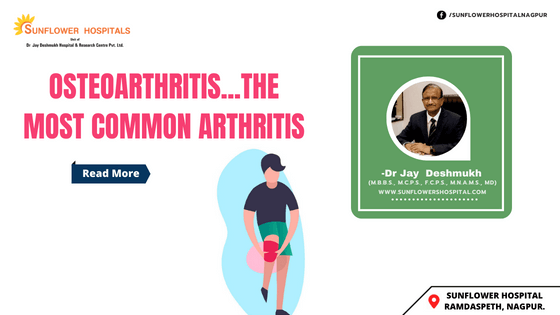What is osteoarthritis?
This is commonly known as the wear and tear type of arthritis. It is associated with the breakdown of cartilage in joints and can occur in almost any joint of the body. There are cushions in between bone ends that form a joint, these are the cartilages. Breakdown of cartilage can occur in any joint in the body. Which joints are generally involved? It commonly occurs in the weight-bearing joints of the hips, knees, and spine. It is known to affect the fingers, thumb, neck, and large toe. The cartilage becomes stiff and loses its elasticity and no longer works as a shock absorber. As the cartilage deteriorates, tendons and ligaments stretch causing pain. In extreme cases, the bones may rub against each other.
Which age group generally gets affected by osteoarthritis?
The chance of getting the disease increases with age. Most people over the age of 60 years have osteoarthritis to some degree. The severity may vary. Even in young people, osteoarthritis can occur. This occurs when there is an underlying joint injury or repetitive joint stress from overuse.
What are the symptoms of osteoarthritis?
Symptoms develop slowly and worsen over a period of time. There would be pain during or after movement. Joint shiftless may be most noticeable after rest or on awakening. The joint is painful if pressure and the chronic inflammatory state associated with obesity is the main reason. Losing extra weight helps in the treatment of osteoarthritis. Both diabetes and high cholesterol levels contribute to the inflammatory response. Controlling high cholesterol and blood glucose levels is important for bone health. Decreased estrogen in postmenopausal women contributes to osteoarthritis. Hereditary factors play a major role.
How do I know that Osteoarthritis is the most common joint condition that affects millions of people worldwide?
Proper exercises, proper posture, and treatment of obesity can help prevent osteoarthritis in the majority of individuals. If not treated in its early phase, it can lead to a chronic disabling form of arthritis needing hip and knee replacement therapies. is applied near it. There would be restrictions on the full range of movement. A crackling or grating sensation may occur on joint movement. There might be swelling around the joint caused by inflammation due to osteoarthritis.
What are the risk factors for osteoarthritis?
In addition to age and repeated trauma to the joints, there are several other risk factors. Obesity is an important cause of osteoarthritis, particularly in those affected at their knees.
Obviously, overloading the weight-bearing mechanisms of the body have osteoarthritis?
Pain due to osteoarthritis develops gradually over many months and years. Activities that put stress on the joints like running or prolonged walking can aggravate the pain. There is generally no fever or weight loss. Examination of X-rays generally confirms the diagnosis. There are no blood tests that diagnose osteoarthritis. MRI is not indicated except in unusual circumstances.
How is osteoarthritis treated?
Exercises, Physiotherapy, intermittent hot and cold packs, weight loss if overweight, healthy food, treatment of diabetes and high cholesterol, supportive devices, injections in the joints, and vitamins and supplements may be helpful. !lain killers are often used under a doctor’s super vision.
What are the goals of treatment?
To improve patient’s quality of life, improve mobility and function, decrease pain and stiffness, and delay further progression.
What about surgery?
This is an option if medical therapy fails. This is an option for severe cases of osteoarthritis. Minimally invasive joint replacement techniques are available. Joint surgery is considered to be very effective in selected cases. It can reduce pain and restore function to a large extent.
What is the role of alternative medications?
Nutritional supplements, vitamins minerals, and other compounds are also useful in certain cases. Glucosamine and Chondroitin have pain-relieving properties, especially for knee osteoarthritis. Though not all experts agree on this. Osteoarthritis can become a chronic disabling disorder. Early introduction of physical therapy and exercises can prevent further damage to the cartilage and joints. Weight reduction and control over high blood glucose and cholesterol would always help to decrease the chronic inflammation associated with osteoarthritis.
Author: Dr Jay Deshmukh
Dr Jay Deshmukh is Chief Physician and Director, Sunflower Hospital, Nagpur Honorary Physician to Honorable Governor of Maharashtra and PondicherryCentral. Dr Jay Deshmukh is an M.B.B.S., M.C.P.S., F.C.P.S., M.N.A.M.S., MD From Internal Medicine – Bombay and New Delhi.


